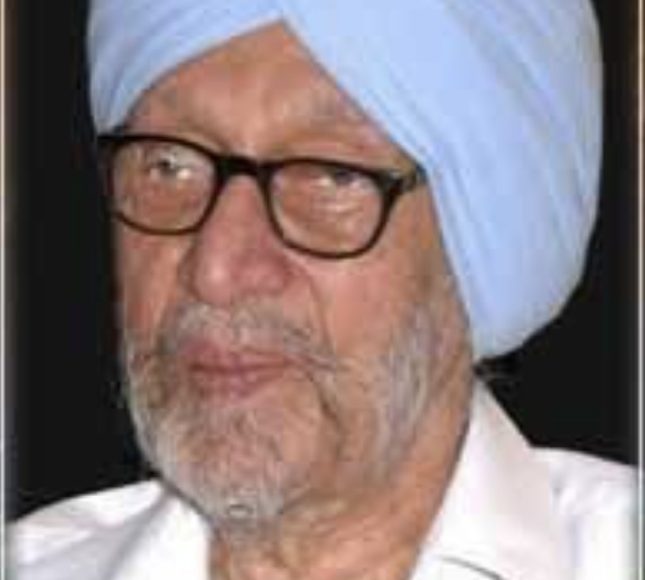Singh, Gurdial born in 1933, is a famous Punjabi novelist, short story writer, and poet. He has written eight novels and five collections of short stories. He presents socio-economic struggle with sentiments and understanding. He did his graduation in 1964 and master of arts (Punjabi) in 1967. Gurdial Singh started his teaching carrier in 1954 with primary classes and was promoted to teach middle and high school students in 1963.
He has been a teacher of Punjabi in Government Brijjindra College, Faridkot (Punjab). He started his literary carrier as a short story writer in 1962 with his collection Saggi phul and then Chan da boota (1964). His subsequent short story collections are Opra admi (1965) and Kulta te admi (1972). But he made his real mark by publishing his maiden novel Marhi da diva (1964). This book was hailed by the Punjabi literary world as one of the best novel written in a regional (Malwai) dialect and got him a literary award from the Language Department, Patiala (Punjab).
His subsequent novels are: Anhoe (1966), Kuwela (1968), Raite de ik muthi (1969), Adh chanani raat (1972) which won the Sahitya Akademi award in 1975, Authen uggan (1974) and Anhe ghore da dam (1976). In addition to this, he has produced some children\’s literature in his books Bakalam khud, Tuk khoh lai kawan and Likhtam Baba Khema. He has also translated a number of books from other languages into Punjabi. Gurdial Singh is more successful when he delineates the rural characters of his native region-Malwa. He has a kind heart and deep sympathy for the poor and the down-trodeen and presents their economic and social struggle with sentiments and understanding.
His regionalism is strength as well as weakness for him. It has earned him name and fame and the title of the best regional Punjabi novelist, but this also stood in his way by limiting his appeal to a particular section of the Punjabi society. Marhi Da Diva narrates the tragedy that overtakes the menial helpers of the farmers in the Punjab villages of the Malwa region, The story of the novel revolves around the farmer Dharam Singh, his wife Dhanno, his son Bhanta, their menial Jagsir, his father Thola and his mother Nandi, the barber Nikka and his wife Bhani and the waterman Raunki.
References :
1. Joginder Singh, Adhunik Punjabi Sahit di Ruparekha.
2. Kaur, B., Adhunika Punjabi Kavi: Sahaj Dristi.
3. Sekhon, S.S. and K.S. Duggal, A History of Punjabi Literature, Delhi, 1992.
Gurdial Singh (1933–2016) is widely recognized as one of Punjabi literature’s most influential novelists, whose work not only redefined narrative storytelling in the Punjabi language but also carved out new spaces for voices from the margins. Born in Bhaini Fateh near Jaitu in British Punjab, he experienced firsthand the hardships of a working-class life—early on working as a carpenter—which profoundly influenced the authentic, unflinching portrayal of rural life in his stories .
A Trailblazer in Realism and Social Commentary
Gurdial Singh’s literary career took off with the publication of his short story “Bhaganwale” in 1957. However, it was his groundbreaking novel Marhi Da Deeva (1964) that established his reputation. Over several iterations, he meticulously refined the narrative, eventually presenting a vivid portrayal of everyday struggles, human frailty, and indomitable resilience. Notably, this novel introduced Punjabi literature’s first Dalit hero—a character whose existence challenged social norms and provided a voice to the otherwise marginalized segments of society. This radical portrayal transformed the literary discourse by opening the doors for a new generation of experimental and socially aware writing in Punjabi .
Literary Craft and Cultural Impact
Gurdial Singh’s work is celebrated for its stark realism, lyrical prose, and deep social consciousness. His narratives, steeped in the textures of local life, encapsulate the painful realities of economic and social disparity while simultaneously celebrating the human spirit. By translating these lived experiences into the form of a novel, he invited readers to confront the harsh truths of rural Punjab, yet offered moments of grace and hope. The enduring appeal of his work is seen not only in literary circles but also through its cinematic adaptations—films like Marhi Da Deeva (1989) and Anhe Ghore Da Daan (2011) have brought his narratives to broader audiences, further cementing his legacy in popular culture .
Awards and Lasting Legacy
For his literary contributions, Gurdial Singh received some of the highest honors in India, including the Padma Shri (1998), the Jnanpith Award (1999), and the Sahitya Akademi Award. His work continues to resonate with readers and scholars alike, serving as a bridge between the lived realities of Punjab’s downtrodden and the aspirations of a society in transition. Through his innovative storytelling and courageous exploration of themes like caste, poverty, and resilience, Gurdial Singh has not only enriched Punjabi literature but also inspired countless writers to explore narratives rooted in social truth.



